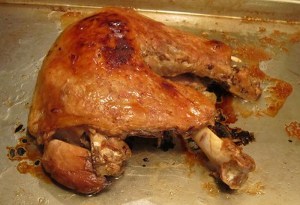Dogs can eat turkey legs because there is nothing in them which is toxic or poisonous to your dog.
But feeding your dog turkey legs is a bit more complicated than that and here’s why.
A turkey leg contains skin, flesh and bone and the trouble is that the bone is better off being fed raw to your dog, the flesh is better off being fed cooked to your dog and as far as the skin is concerned, your dog shouldn’t touch it raw or cooked!
Let me explain all of that.
What is wrong with turkey skin?
Let me start with the skin, since my judgement of it was so harsh.
Turkey skin is 39% fat and 13% protein.
Most people know about the fat content but few people are aware of the fact that it contains quite a bit of protein.
Proteins contain amino acids which are crucial in how they help a dog’s body to fight disease.
Surprisingly, turkey skin also contains a decent amount of the vitamins B3 and B12- which play an important role in turning food into energy.
But, and it is a big but, because turkey skin is so high in fat, it might upset your dog’s stomach- just so you know.
Should dogs eat turkey leg meat?
Turkey leg meat is much safer fed to dogs cooked.
This is because turkey meat is poultry and so it might contain a couple of nasty bacterias.
And the most worrying ones are campylobacter and salmonella, which at its worst can kill people and their dogs.
It is difficult to know how common these bacteria are in raw turkey but there was a lethal outbreak of salmonella which was linked to raw turkey in 2019.
The good news is that cooking turkey properly kills this bacteria.
How nutritious is turkey leg meat?
Turkey leg meat is packed full of nutrients.
Only 6% of it is fat (compared to the skin which is 39% fat) and 28% is protein.
Like the skin, turkey leg meat is high in vitamins B12 and B3 but it provides large doses of B2 and B6.
Mineral- wise, the leg meat contains a large amount of selenium, phosphorus and zinc.
Can dogs eat turkey leg bones?
Dogs can eat turkey leg bones but they should be eaten raw.
I know, it directly contradicts my advice about cooking turkey flesh.
The thing is that when bones are cooked (as they are for your Thanksgiving turkey) they become brittle.
This is dangerous for dogs because when they bite on a cooked bone, it tends to shatter into smaller, sharper pieces compared to an uncooked bone.
And these sharp pieces of bone present two dangers to your dog.
Firstly, that they get stuck somewhere in your dog’s throat.
And secondly that they cut part of your dog’s digestive system as they pass through.
Raw or uncooked bones are softer and tear instead of shatter.
If it is any consolation, the leg bone is the best bone to eat on the turkey’s body.
If it is one guiding principle to not give dogs cooked bones, another guiding principle is that dogs should only eat weight bearing bones.
Lots of people get caught up in whether they should feed their dogs pork or beef or chicken bones, which is an important consideration..
But not as important as the consideration of what part of the body the bone should come from- irrespective of the type of animal it is from.
Weight bearing or leg bones from all animals are the best bones for a dog because these bones are heavier and denser and less likely to splinter when they are bitten into.
The easy and best option with turkey legs
So, where does that leave you?
After all of that, there isn’t an easy option for you.
The easiest would be to throw your dog a turkey leg straight after your Thanksgiving meal.
But with the skin still on and the bone having been cooked, that option comes with risks.
The next easiest option would be to break a leg off your turkey before you put it in the oven and feed it to your dog raw.
But although the bone will be perfectly safe for your dog, you have the risk of the raw meat containing some bacteria and that fatty piece of skin to contend with.
Without an easy option, perhaps we should discuss your best option.
And to me that would be feeding your dog cooked turkey leg meat.
Don’t feed your dog any turkey skin or the cooked bones.
How to use cooked turkey bones with your dog?
Just because you can’t feed your dog cooked turkey leg bones, doesn’t mean that you can’t use those cooked turkey leg bones for your dog.
One of the great things about feeding your dogs scraps of meat or bones from the meat that we cook for ourselves, is that it means that we are creating less waste by throwing less in the trash.
And that is a really good thing and it can make us feel great.
So instead of resigning those cooked leg bones to the bin, why don’t you make a simple broth with the rest of the turkey carcass?
You can then feed this broth to your dog.
All you need for your broth is a large cooking pot, turkey bones, lots of water, apple cider vinegar or lemon juice and lots of time.
Letting it cook for at least 24 hours achieves the best results.
There is a great dog recipe at the bottom of this page.
Why is turkey bone broth so good for your dog?
There are several benefits or health boosts that a dog can get from eating bone broth.
By cooking the bones for so long, the bones are softened and lots of the nutrients within them are released.
Bone broth contains many powerful nutrients that can boost a dog’s health system.
Two of the most important ones are; amino acids and gelatine.
Amino acids, which will help boost a dog’s immune system because of the way that they can help fight “free radicals”.
Another important nutrient is gelatine which can help with digestion because this jelly like substance can repair leaks or gaps in a digestive system, making things work better.
What is wrong with smoked turkey legs?
We have discussed at some length why cooked turkey legs may not be the best thing to give to your dog.
And smoked turkey legs are even worse.
Not only will smoked turkey legs probably be brittle but they will also be smoked.
And there is a growing body of evidence to suggest that smoked foods carry an increased risk of cancer.
To reiterate, the food need only be smoked, not charred.
Plus from what I have read, dogs don’t particularly like that smoked flavour.
Can dogs eat turkey giblets?
Turkey giblets are the heart, liver, neck and gizzard.
A gizzard, for all of you who are scratching your head, is a muscle within the turkey’s stomach that grinds their food.
All of these bits of turkey are very nutritious and can be fed to your dog as long as they are cooked.
As an obscure example, turkey neck is 22% protein and is very high in vitamin B12.
Does a turkey contain any other vitamin, you may ask?!
The only giblet that you should be a bit cautious about is turkey liver.
This is because the liver in any animal contains a colossal amount of vitamin A and so the amount that you feed your dog should be minimal.
But the size of a turkey’s liver is so small that your dog should be OK- as long as they don’t overdose on all the neighbour’s turkey giblets?
Closing Thoughts
I think I might have burst your Thanksgiving turkey dog bubble.
If you had a picture in your mind of tearing off a turkey leg and casually tossing it to Fido at the end of your main meal, I’m really sorry.
I mean you can, and if you are in an alcohol haze, you probably will.
But doing that does carry some risk.
Your best option is to just feed your dog a little cooked turkey leg meat- strip away the skin and take it off the bone.
Another factor to consider over Thanksgiving is that your local vet will tend to be closed and only running an emergency call out service- with price hikes to match.
I don’t know if that will influence your thinking?!







